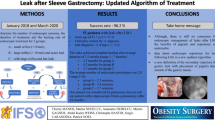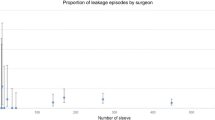Abstract
Purpose
To propose an algorithm of treatment for leakage after laparoscopic sleeve gastrectomy (LSG).
Materials and Methods
Sixty-nine patients who developed gastric leakage out of 4294 patients who underwent LSG from 2010 to 2018 were considered in this study. Patients’ outcomes in terms of incidence of resolution and time to leakage resolution were compared by leakage characteristics and type of treatment. Three patients were lost to follow up.
Results
Leakage occurred in a median of 6 days from surgery, and for majority of patients (80.3%), it was in the upper part of the sleeve. The median dimension of leakage was 6.5 mm. Low level leakage resulted in a lower time of resolution (p < 0.001). Patients with clinical leakage were treated with surgery or endoscopic placement of a self-expandable metal stent (SEMS). The median time of leakage resolution was 42 days. The hospitalization time for SEMS was shorter with a 68.3% of complete resolution compared with the 29.4% of surgery. In patients with subclinical and small leakage, a conservative treatment was successful in 87.5%. Overall 39.4% of patients needed a second line treatment after that the first failed.
Conclusion
Leakage could be treated conservatively if subclinical and < 5 mm. Surgery is mandatory if a perigastric collection is present or an organ lesion is suspected. SEMS seems to be the best option to treat high level leakage.

Similar content being viewed by others
References
Angrisani L, Santo Nicola A, Iovino P, et al. IFSO worldwide survey 2016: primary, endoluminal, and revisional procedures. Obes Surg. 2018;28:3783–94. https://doi.org/10.1007/s11695-018-3450-2.
Baker RS, Foote J, Kemmeter P, et al. The science of stapling and leaks. Obes Surg. 2004;14(10):1290–8. Review. Erratum in: Obes Surg. 2013 Dec;23(12):2124
Iossa A, Abdelgawad M, Watkins BM, et al. Leaks after laparoscopic sleeve gastrectomy: overview of pathogenesis and risk factors. Langenbeck's Arch Surg. 2016;401(6):757–66. https://doi.org/10.1007/s00423-016-1464-6. Review
Saber AA, Azar N, Dekal M, et al. Computed tomographic scan mapping of gastric wall perfusion and clinical implications. Am J Surg. 2015;209(6):999–1006. https://doi.org/10.1016/j.amjsurg.2014.05.023.
Cesana G, Cioffi S, Giorgi R, et al. Proximal leakage after laparoscopic sleeve gastrectomy: an analysis of preoperative and operative predictors on 1738 consecutive procedures. Obes Surg. 2018;28(3):627–35. https://doi.org/10.1007/s11695-017-2907-z.
Aurora AR, Khaitan L, Saber AA. Sleeve gastrectomy and the risk of leak: a systematic analysis of 4,888 patients. Surg Endosc. 2012;26(6):1509–15. https://doi.org/10.1007/s00464-011-2085-3. Review
Stroh C, Köckerling F, Volker L, et al. Results of more than 11,800 sleeve gastrectomies: data analysis of the German bariatric surgery registry. Ann Surg. 2016;263(5):949–55. https://doi.org/10.1097/SLA.0000000000001559.
Fernandez Jr AZ, DeMaria EJ, Tichansky DS, et al. Experience with over 3,000 open and laparoscopic bariatric procedures: multivariate analysis of factors related to leak and resultant mortality. Surg Endosc. 2004;18(2):193–7. Review
Gagner M, Buchwald JN. Comparison of laparoscopic sleeve gastrectomy leak rates in four staple-line reinforcement options: a systematic review. Surg Obes Relat Dis. 2014;10(4):713–23. https://doi.org/10.1016/j.soard.2014.01.016. Review
Csendes A, Braghetto I, León P, et al. Management of leaks after laparoscopic sleeve gastrectomy in patients with obesity. J Gastrointest Surg. 2010;14(9):1343–8. https://doi.org/10.1007/s11605-010-1249-0.
Welsch T, von Frankenberg M, Schmidt J, et al. Diagnosis and definition of anastomotic leakage from the surgeon's perspective. Chirurg. 2011;82(1):48–55. https://doi.org/10.1007/s00104-010-1916-4.Review.German.
Nedelcu M, Skalli M, Delhom E, et al. New CT scan classification of leak after sleeve gastrectomy. Obes Surg. 2013;23(8):1341–3. https://doi.org/10.1007/s11695-013-1002-3.
Gonzalez R, Sarr MG, Smith CD, et al. Diagnosis and contemporary management of anastomotic leaks after gastric bypass for obesity. J Am Coll Surg. 2007;204(1):47–55.
Abou Rached A, Basile M, El Masri H. Gastric leaks post sleeve gastrectomy: review of its prevention and management. World J Gastroenterol. 2014;20(38):13904–10. https://doi.org/10.3748/wjg.v20.i38.13904. Review. PubMed PMID: 25320526; PubMed Central PMCID: PMC4194572
Nimeri A, Ibrahim M, Maasher A, et al. Management algorithm for leaks following laparoscopic sleeve gastrectomy. Obes Surg. 2016;26(1):21–5. https://doi.org/10.1007/s11695-015-1751-2.
Al Hajj G, Chemaly R. Fistula following laparoscopic sleeve gastrectomy: a proposed classification and algorithm for optimal management. Obes Surg. 2018;28(3):656–64. https://doi.org/10.1007/s11695-017-2905-1.
Foschi D, De Luca M, Sarro G, et al. Linee guida di Chirurgia dell’Obesità. Edizione 2016. SICOB.
Walsh C, Karmali S. Endoscopic management of bariatric complications: a review and update. World J Gastrointest Endosc. 2015;7(5):518–23. https://doi.org/10.4253/wjge.v7.i5.518. Review. PubMed PMID: 25992190; PubMed Central PMCID: PMC4436919
Author information
Authors and Affiliations
Corresponding author
Ethics declarations
Conflict of Interest
The the authors declare that they have no conflict of interest.
Ethical Approval
All procedures in this study were in accordance with the ethical standards of the institutional and/or national research committee and with the 1964 Helsinki declaration and its later amendments or comparable ethical standards.
Informed Consent
Informed consent was obtained from all individual participants included in the study.
Additional information
Publisher’s Note
Springer Nature remains neutral with regard to jurisdictional claims in published maps and institutional affiliations.
Stefano Olmi is a “Contract Professor” of the General Surgery Faculty and a teacher in the Residency Program.
Giovanni Cesana and Francesca Ciccarese are “Tutor” in the General Surgery Residency Program.
Carolina Rubicondo is a Resident in General Surgery.
Rights and permissions
About this article
Cite this article
Olmi, S., Cesana, G., Rubicondo, C. et al. Management of 69 Gastric Leakages after 4294 Consecutive Sleeve: The Experience of a High Volume Bariatric Center. OBES SURG 30, 3084–3092 (2020). https://doi.org/10.1007/s11695-020-04658-2
Published:
Issue Date:
DOI: https://doi.org/10.1007/s11695-020-04658-2




